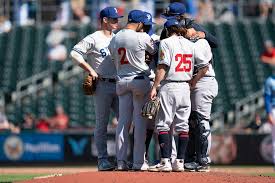In the world of baseball, various acronyms and stats play a crucial role in understanding the game and its strategies. One such abbreviation that may not be as well-known but is still important is MVR. The MVR Baseball stat stands for Mound Visits Remaining. This unique counting measure, introduced by Major League Baseball in 2018, governs the number of times a team can legally visit the mound during a game without making a pitching change.
MVR was designed to help speed up the pace of play without compromising the strategic aspects of the game. As of the 2020 season, each team is allowed five mound visits per game, giving managers, coaches, and players on the offensive team a certain number of opportunities to approach the mound and meet with their pitcher throughout the game. This rule not only impacts pace but also adds an additional layer of strategy to the game, as teams must carefully consider when to use their remaining mound visits.
Contents
Overview of MVR Baseball Stat
MVR, which stands for Mound Visits Remaining, is a rule in baseball that dictates the number of times managers, coaching staff, and other players on the offensive team are allowed to approach the mound to meet with their pitcher. This rule was instituted by Major League Baseball (MLB) in 2018 to speed up the game and eliminate unnecessary delays.
As of the 2020 season, each team is permitted to make five mound visits per game.. The MVR is a counting measure displayed on the scoreboard, showing how many mound visits a team has left in the game. It is important to note that MVR is not a statistic but a counting measure put in place to regulate the number of mound visits.
The implementation of the MVR rule has had a noticeable impact on the pace of play in MLB games. Coaches and managers must now strategically decide when to visit the mound, taking into account the importance of the current game situation and the number of visits remaining. This has led to a decrease in unnecessary meetings and ultimately a faster pace of play.
Calculating MVR
MVR (Mound Visits Remaining) is an important baseball statistic used to monitor the number of mound visits a team has left during a game. In this section, we will explore the components and formulas of MVR and provide an example calculation.
Components and Formulas
The primary component of MVR is the number of mound visits a team is initially allowed. According to the rules instituted by Major League Baseball in 2018, each team is allowed five mound visits per game.
Calculating MVR is quite simple; you just need to subtract the total number of mound visits used from the total number of mound visits allowed. The formula is as follows:
MVR = Total Mound Visits Allowed - Mound Visits Used
It is important to keep track of this statistic as it directly influences a team’s remaining strategy during a game.
Example Calculation
Let’s consider a baseball game where Team A has already used three mound visits. To determine their MVR, we can use the formula mentioned above.
| Total Mound Visits Allowed | Mound Visits Used |
|---|---|
| 5 | 3 |
Applying the formula:
MVR = 5 - 3
MVR = 2
From this calculation, it is evident that Team A has two mound visits remaining for the rest of the game.
Understanding MVR Analysis
In this section, we will discuss the analysis of the MVR (Mound Visits Remaining) baseball stat, which has been implemented in Major League Baseball since the 2018 season. We will delve into the strengths and weaknesses of MVR analysis, as well as the context and interpretation of this stat.
Strengths and Weaknesses
MVR provides valuable information on a team’s strategy and the remaining number of allowed mound visits. This helps coaching staffs, players, and fans understand how many strategic visits are left in a game. However, there are a few limitations when analyzing MVR. For example, the rule of mound visits may vary from league to league, which can impact the analysis.
Furthermore, MVR alone cannot capture the effectiveness of mound visits or how well pitchers and catchers communicate. This could potentially lead to false assumptions about a team’s performance based on MVR. Despite these weaknesses, MVR serves as a useful stat to measure the remaining visits and abide by the current MLB rules.
Context and Interpretation
When interpreting MVR, it is essential to consider the context of a game and the specific situations that may require mound visits. For instance, high-pressure games, high-scoring situations, or inexperienced pitchers may warrant more mound visits than usual. Understanding these scenarios will provide insight into why MVR is being utilized the way it is during a game.
Moreover, it is crucial to recognize that MVR is just one of many stats used to analyze a team’s performance. A comprehensive analysis should include consideration for other stats such as runs scored, earned run average, and total hits alongside MVR.
In summary, MVR analysis provides valuable information on mound visits remaining within a game, which can impact strategic decisions made by coaching staffs and players. However, it is essential to consider the context of a game and interpret MVR alongside other baseball metrics to gain a better understanding of a team’s overall performance.
History and Evolution of MVR Stat
In the past, there were no restrictions on the number or duration of mound visits in baseball. However, to speed up the game and prevent continuous interruptions, the MLB introduced a time limit for mound visits in 2016, and later, the MVR (Mound Visits Remaining) rule in 2018.
Initially, the 2016 season brought a 30-second time limit for mound visits, which aimed to reduce dead time in games and keep the pace more suitable for audience engagement. Although this was a step towards a more efficient game, it was not a comprehensive solution and left room for improvement.
With the 2018 season, the MLB introduced the MVR rule, imposing a new limitation on mound visits. Players and coaches were allowed only six mound visits per match, meaning that the offensive team had to be more strategic about when and why to approach the mound during a game. The MVR rule has made a significant impact on the conduct of the game since its introduction, making it more time-efficient and engaging for both players and spectators.
It is interesting to note that the origin of this concept can be traced back to a game on August 18, 2001, when the Tampa Bay Rays played against the Detroit Tigers. During that game, the Tigers manager, Phil Garner, argued with the umpire about time consumed during a pitching change, which eventually led to his ejection from the game.
Since its introduction, the MVR rule has become an essential part of baseball games, contributing to a more fluid and dynamic experience on the field. While the mound visit limit is relatively new in baseball history, its impact on the game is undeniably significant and here to stay.
MVR in Advanced Baseball Statistics
The MVR stat, or Mound Visit Remaining, is a term used in advanced baseball statistics to indicate the number of times a manager, coaching staff, and other players on the offensive team are allowed to approach the mound to meet with their pitcher during a game. This rule was introduced by Major League Baseball in 2018 to help regulate and control the pace of the game.
As of the 2020 season, each team is permitted a total of five mound visits per game. These mound visits can be used strategically by the team to discuss game tactics, provide a breather for the pitcher, or make adjustments to the pitcher’s technique.
While the MVR stat may not provide direct insights into a player’s performance, it does offer valuable information on how a team utilizes its mound visits and potentially affects the flow and momentum of the game. Monitoring MVR throughout the season can help teams analyze the effectiveness of their mound visits and make adjustments as needed.
It’s essential for teams to manage their mound visits effectively and use them wisely as each mound visit can directly impact a game’s outcome, especially in high-pressure situations. Using MVR as part of the broader set of advanced baseball statistics can help teams better understand, strategize, and ultimately become more successful in executing their game plans.
Comparing MVR to Other Baseball Metrics
In the world of baseball statistics, Mound Visits Remaining (MVR) is relatively new and unique compared to other commonly tracked metrics. Introduced in 2018, MVR provides a count of how many mound visits a team is permitted during a game, with the current limit set at five visits per team, per game.
While MVR addresses the interaction between players, coaches, and managers in relation to pitching changes, traditional baseball metrics are primarily focused on measuring individual and team performance. Some key examples include:
- Batting Average (BA) – Measures a player’s hitting performance by dividing the number of hits by the total number of at-bats.
- On-Base Percentage (OBP) – Shows the frequency at which a player reaches base by taking the sum of hits, walks, and hit by pitches, and dividing it by the sum of at-bats, walks, hit by pitches, and sacrifice flies.
- Earned Run Average (ERA) – Calculates the average number of earned runs a pitcher allows per nine innings pitched.
- Fielding Percentage (FP) – Assesses a player’s defensive performance by dividing the sum of putouts and assists by the sum of putouts, assists, and errors.
Comparatively, MVR is more focused on game management and strategy, whereas other baseball metrics provide insights into player-specific skills and team performance. As a result, MVR may not be as immediately impactful on the outcome of a game as the traditional metrics, but it can still play an integral role in a team’s strategy and decision-making process.
Since MVR was implemented to reduce game disruptions and improve the pace of play, it represents a unique intersection of game management and keeping the audience engaged. Despite its relatively recent inception, MVR adds another layer of complexity to the already intricate landscape of baseball statistics.
Conclusion
In the world of baseball, MVR (mound visits remaining) is an important stat aimed at keeping the game moving at a steady pace. This rule, introduced in 2018, limits the number of times a team can approach the mound to meet with their pitcher during a game. By implementing this constraint, unnecessary delays are reduced and the flow of the game is maintained.
Teams are required to use strategic decision-making when managing their mound visits, as there is a fixed number of visits allowed. The purpose of the MVR rule is not only to speed up the game but also to discourage stalling through excessive pitching changes. This change in baseball dynamics has made managers, coaching staff, and players adapt their planning and communication strategies during the course of a game.
Mound visits are all about jolting a shift in perspective.
Telling someone NOT to do something is not as helpful as telling them TO do something.
Rather than saying “don’t overthink it,” say what they should do.
“Compete your ass off until I rip this ball out of your hands” https://t.co/SATobMk9Ki pic.twitter.com/p42balN6t5
— Ben Brewster (@TreadAthletics) March 15, 2023
In conclusion, the MVR stat in baseball has played a substantial role in improving the overall flow and tempo of the game. The rule encourages teams to better strategize their mound visits and enhances the overall experience for both players and spectators. As baseball continues to evolve, the MVR rule highlights the importance of adapting the game to meet the needs of modern audiences.


